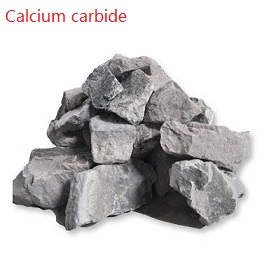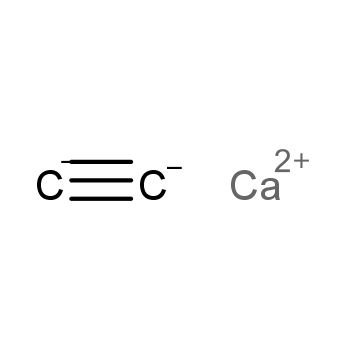Calcium carbide
- CAS No.: 75-20-7
- Molecular Weight:64.0994
- Modify Date.: 2022-11-25 02:22
- Introduction:
Calcium carbide, with the chemical formula CaC2 and CAS registry number 75-20-7, is a compound known for its role in the production of acetylene gas. This colorless crystalline solid is characterized by its ability to react with water to produce acetylene gas, which is widely used in industries such as welding and cutting. Calcium carbide is also used in the production of calcium cyanamide, a nitrogen fertilizer. Additionally, it can be used as a desulfurizing agent in the steel industry. Calcium carbide has been studied for its potential use in the synthesis of various organic compounds and as a source of carbon in the production of graphene. It is an important compound in the field of chemistry and industrial applications, contributing to the development of various technologies and processes.
View more+
1. Names and Identifiers
- 1.1 Name
- Calcium carbide
- 1.2 Synonyms
Acetylen,Calciumcarbid acetylene,calcium carbide Acetylenestones Acetylenogen Calcium Carbide, Anhydrous CALCIUM ACETYLIDE Calcium Carbide, 10-40 Mesh Calciumcarbid calciumcarbide(cac2) calciumdicarbide carbide carburedecalcium carburedecalcium(french) carburocalcico EINECS 200-848-3 ELECTROLITE MFCD00010905
- View all
- 1.3 CAS No.
- 75-20-7
- 1.4 CID
- 6352
- 1.5 EINECS(EC#)
- 200-848-3
- 1.6 Molecular Formula
- C2Ca (isomer)
- 1.7 Inchi
- InChI=1S/C2.Ca/c1-2;/q-2;+2
- 1.8 InChIkey
- UIXRSLJINYRGFQ-UHFFFAOYSA-N
- 1.9 Canonical Smiles
- [C-]#[C-].[Ca+2]
- 1.10 Isomers Smiles
- [C-]#[C-].[Ca+2]
2. Properties
- 2.1 Density
- 2.22
- 2.1 Melting point
- 447℃
- 2.1 Boiling point
- 2300℃
- 2.1 Precise Quality
- 63.96260
- 2.1 PSA
- 0.00000
- 2.1 logP
- 0.16260
- 2.1 Appearance
- Gray-black pieces
- 2.2 Storage
- Moisture Sensitive. Ambient temperatures.
- 2.3 Chemical Properties
- grey or black solid with a garlic-like odour
- 2.4 Color/Form
- Gray-black
- 2.5 Water Solubility
- HYDROLYSES
- 2.6 Stability
- Stability Reacts violently with water liberating highly flammable gas (acetylene). Do not use water if this material is involved in a fire. Incompatible with moisture, water, strong oxidizing agents, alcohols, hydrogen chloride, magnesium.
- 2.7 StorageTemp
- water-free area
3. Use and Manufacturing
- 3.1 General Description
- Grayish-black irregular lump solid. Used to make acetylene and in steel manufacture.
4. Safety and Handling
- 4.1 Symbol
- GHS02, GHS05, GHS07
- 4.1 Hazard Codes
- F
- 4.1 Signal Word
- Danger
- 4.1 Risk Statements
- R15
- 4.1 Safety Statements
- S43;S8
- 4.1 Packing Group
- II
- 4.1 Fire Hazard
- Behavior in Fire: If wet by water, highly flammable acetylene gas is formed.
- 4.2 Hazard Class
- 4.3
- 4.2 Hazard Declaration
- H260-H315-H318-H335
- 4.2 RIDADR
- UN 1402
- 4.2 Caution Statement
- P223-P231 + P232-P261-P280-P370 + P378-P422
- 4.2 WGK Germany
- 1
- 4.2 Report
-
Reported in EPA TSCA Inventory.
- 4.3 Safety
-
Hazard Codes:?F
Risk Statements: 15?
R15:Contact with water liberates extremely flammable gases.
Safety Statements: 8-43-43A?
S8:Keep container dry.?
S43:In case of fire use ... (there follows the type of fire-fighting equipment to be used.)
RIDADR: UN 1402 4.3/PG 2
WGK Germany: 1
F: 10-21
HazardClass: 4.3
PackingGroup: II
Reaction on contact with moisture forms explosive acetylene gas. Flammable on contact with moisture, acid or acid fumes; evolves heat or flammable vapors. Moderate explosion hazard. Incandescent reaction with Cl2 (245°C), Br2 (350°C), I2 (305°C), HCl gas + heat, PbF2, Mg + heat. Incompatible with Se, (KOH + Cl2), AgNO3, Na2O2, SnCl2, S, water. Mixtures with iron(III) chloride, iron(III) oxide, tin(II) chloride are easily ignited and burn fiercely. Vigorous reaction with methanol after an induction period. Addition to silver nitrate solutions precipitates the dangerously explosive silver acetylide. Copper salt solutions behave similarly. See also CALCIUM HYDROXIDE and ACETYLENE.
- View all
- 4.4 Sensitive
- Moisture Sensitive
- 4.5 Specification
-
?Calcium carbide (CAS NO.75-20-7) is also named as AI3-03101 ; Acetylenogen ; Calcium acetylide (Ca(C2)) ; Calcium carbide (CaC2) ; Calcium dicarbide ; Carbure de calcium ; Carbure de calcium [French] ; Carburo calcico ; Carburo calcico [Spanish] ; Ethyne, calcium deriv. ; HSDB 1434?.?Calcium carbide (CAS NO.75-20-7) is grey or black solid with a garlic-like odour. It can reacts rapidly with water to generate the flammable gas acetylene and the base calcium hydroxide. Enough heat may be generated to ignite the gas. Calcium carbide is a reducing agent. May react vigorously with oxidizing materials. The powdered mixture of the acetylide and iron oxide and iron chloride burns violently upon ignition, producing molten iron. Calcium carbide incandesces with chlorine, bromine, or iodine at 245, 350, or 305 °C., respectively. The carbide burns incandescently when mixed and heated with lead difluoride, magnesium, hydrogen chloride, and tin (II) chloride,?respectively. Interaction of Calcium carbide with methanol to give calcium methoxide is vigorous , but subject to an induction period of variable length. Once reaction starts, evolution of acetylene gas is very rapid, unpublished observations. Mixing Calcium carbide with silver nitrate solutions forms silver acetylide, a highly sensitive explosive. Copper salt solutions would behave similarly. The mixture of Calcium carbide and sodium peroxide is explosive, as is Calcium carbide and perchloryl fluoride as gases at 100-300 °C.? Eye and skin will?irritate by?Calcium carbide .?If wet by water, highly flammable acetylene gas is formed.?
- View all
- 4.6 Toxicity
- Eye and skin irritation
5. MSDS
2.Hazard identification
2.1 Classification of the substance or mixture
Substances and mixtures, which in contact with water, emit flammable gases, Category 1
2.2 GHS label elements, including precautionary statements
| Pictogram(s) |  |
| Signal word | Danger |
| Hazard statement(s) | H260 In contact with water releases flammable gases which may ignite spontaneously |
| Precautionary statement(s) | |
| Prevention | P223 Do not allow contact with water. P231+P232 Handle and store contents under inert gas/.... Protect from moisture. P280 Wear protective gloves/protective clothing/eye protection/face protection. |
| Response | P302+P335+P334 IF ON SKIN: Brush off loose particles from skin. Immerse in cool water [or wrap in wet bandages]. P370+P378 In case of fire: Use ... to extinguish. |
| Storage | P402+P404 Store in a dry place. Store in a closed container. |
| Disposal | P501 Dispose of contents/container to ... |
2.3 Other hazards which do not result in classification
none
6. Synthesis Route
75-20-7Total: 15 Synthesis Route
8. Other Information
- 8.0 Usage
- Calcium carbide is used as a desulfurizer, dehydrant of steel, fuel in steel making, powerful deoxidizer and as a source of acetylene gas. It is used as a starting material for the preparation of calcium cyanamide, ethylene, chloroprene rubber, acetic acid, dicyandiamide and cyanide acetate. It is used in carbide lamps, toy cannons such as the big-bang cannon and bamboo cannon. It is associated with calcium phosphide and used in floating, self-igniting naval signal flares. Further, it is involved in the reduction of copper sulfide to metallic copper.
- 8.1 Merck
- 14,1656
- 8.2 BRN
- 3909011
- 8.3 Description
- Calcium carbide (molecule formula: CaC2), is a kind of important chemical raw materials produced from the chemical processing of limestone. In 1892, H. Maysan (French) and H. Wilson (United state) simultaneously developed a calcium carbide production approach based on furnace Reduction. The United State had successfully achieved industrial production in 1895. The property of calcium carbide is related to its purity. Its industrial product is mostly the mixture of calcium carbide and calcium oxide, and also contains trace amounts of sulfur, phosphorus, nitrogen and other impurities. With the increasing content of impurities, it color exhibits gray, brown to black. The melting point and electrical conductivity both decrease with the decrease of the purity. The purity of its industrial product is usually 80% with m.p. being 1800~2000 °C. At room temperature, it does not react with air, but it can have oxidation reaction at above 350 ℃, and have reaction with nitrogen at 600~700 ℃ to generate calcium cyanamide. Calcium carbide, when coming across with water or steam, generates acetylene and release a large amount of heating. CaC2 + 2H2O─ → C2H2 + Ca (OH) 2 + 125185.32J, 1kg of pure calcium carbide can produce 366 L of acetylene 366l (15 ℃, 0.1MPa). Thereby, for its storage: calcium carbide should be strictly kept away from water. It is usually packed in a sealed iron container, and sometimes stored in a dry warehouse being filled with nitrogen if necessary.

- View all
- 8.4 Uses
-
9. Question & Answer
-
Introduction: Calcium Carbide, also known as calcium carbide, is a high -energy industrial raw material and one of the basic raw materials for organic synthetic chemistry industry. Calcium Carbide is..
-
The chemical name of calcium carbide is Calcium carbide, and its molecular formula is CaC2. Chemically pure Calcium carbide is almost colorless and transparent, and extremely pure Calcium carbide is a..
-
Here is the reaction: CaC₂(s) + 2H₂O(l) → Ca(OH)₂(s) + C₂H₂(g) This industrial reaction nowadays has been superseded by other methods, so that the use of calcium carbide has been steadily droppi..
-
I have an old lantern that runs on calcium carbide and water. The acetylene gas produced is ignited by a match and produces a weak, sooty flame. When I was young, my dad used to fire up the lantern. I..
10. Recommended Suppliers
-
- Products:Cosmetic Raw Materials,solvents,etc.
- Tel:86-311-66562153
- Email:breeduan@crovellbio.com
-
- Products:Medical Intermediate,Lithium Battery Additive,Organicetc Chemical, Organic Chemical, Paint Chemical and Detergent Chemical etc..
- Tel:0086-0371-55170693
- Email:info@tianfuchem.com
-
- Products:Export business of hi-tech products such as pharmaceutical materials (APIs), pharmaceutical intermediates, fine chemicals and biochemical reagents, etc.
- Tel:86-571-86465881
- Email:sales9@dingyanchem.com
-
- Products:finechemicals, pharmaceutical materials and intermediates, pesticides, dyes andbiochemical reagents.
- Tel:86-571-56123425
- Email:purchase@kieraychem.com
-
- Products:Chemical raw materials are widely used in paint, coating industry, rubber industry, water treatment industry and feed industry, etc.
- Tel:86-538-6301415
11. Realated Product Infomation








